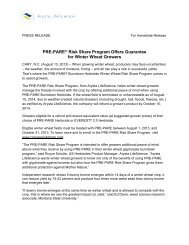Product Guide - Arysta LifeScience
Product Guide - Arysta LifeScience
Product Guide - Arysta LifeScience
Create successful ePaper yourself
Turn your PDF publications into a flip-book with our unique Google optimized e-Paper software.
THE PROBLEM WITH POA<br />
Every golf course has its particular problem weed that impairs playability. For most, it’s Poa annua.<br />
Poa produces bumpier-than-normal playing conditions, a major issue for playability.<br />
One of the most common and widely distributed grassy weeds in the world, Poa annua is also one of<br />
the most difficult to control on turfgrass, especially in creeping bentgrass. Bentgrass provides conditions<br />
that are ideal for Poa annua growth, including high moisture, nitrogen, high traffic levels and routine<br />
fungicide use. 1 There’s never been a real solution for eliminating Poa annua. Until now.<br />
NEW CHEMISTRY. NEW STRATEGY.<br />
XONERATE (Amicarbazone) is a post-emergent herbicide that represents a new turfgrass chemistry<br />
for golf courses. XONERATE doesn’t just manage or suppress Poa annua, it eliminates it.<br />
POA ANNUA<br />
XONERATE 70 WDG contains 70% Amicarbazone in a water-dispersible granule formulation. It’s<br />
absorbed by leaves and roots and inhibits photosynthesis in sensitive plants by interfering with<br />
normal electron transport.<br />
XONERATE DIFFERENCE<br />
• Selective removal of Poa annua in many cool and warm season turfgrasses including creeping bentgrass and Bermuda grass.<br />
• The ability to re-seed creeping bentgrass at seven or more days after the last application in roughs, fairways and tees.<br />
• The ability to apply in the spring at six months after seeding creeping bentgrass, and other cool season turfgrasses in the fall<br />
months of the previous year.<br />
• Control of Poa annua within three to four weeks. 2<br />
• Cost savings associated with eliminating Poa annua may include reduced labor from less frequent mowings, reduced use of<br />
fungicides, insecticides and plant growth regulators.
HOW TO APPLY XONERATE<br />
XONERATE can be applied up to four times at a 1-ounce/acre rate for bentgrass. (KBG and KBG/Ryegrass up to 2 oz rate at 2<br />
applications). It should be used on turf that has smaller percentages of Poa annua (less than 10 percent Poa annua population),<br />
while transitioning to desirable turfgrass. 2<br />
APPLICATION STEPS<br />
• Apply in spring months (early summer in Northern United States), two to four weeks after active creeping<br />
bentgrass growth resumes.<br />
• Make applications at air temperatures of 55 – 80° F.<br />
• Temperatures should not exceed 80° F (KBG temp range up to 85° F).<br />
• Repeat the application at seven-day intervals for a maximum of up to four applications (applications should<br />
cease once Poa annua control is at an acceptable level, no Poa annua remains, or after four applications). 2<br />
• Repeat applications should be made in the opposite direction as the previous application.<br />
• Creeping bentgrass can be seeded at seven or more days after the last application of XONERATE.<br />
• XONERATE may be applied in the spring at six months after seeding creeping bentgrass in the fall months of<br />
the previous year.<br />
• XONERATE may be tank-mixed. Water is the recommended liquid carrier (please read all label information carefully).<br />
TURF SPECIES ACCEPTABLE FOR XONERATE<br />
XONERATE should only be applied to sites that are composed of the following turfgrass species unless trial use has indicated that<br />
the turf species not listed here is tolerant to Amicarbazone DF. Apply to turfgrasses established for six months unless otherwise<br />
directed on this label. See the XONERATE label for use on specific turf species.<br />
COOL-SEASON TURFGRASSES 3<br />
Bentgrass, Creeping<br />
Agrostis stolonifera<br />
Bluegrass, Kentucky<br />
Poa pratensis<br />
Fescue, Fine<br />
Festuca sp.<br />
Fescue, Tall<br />
Festuca arundinacea<br />
Ryegrass, Perennial<br />
Lolium perenne<br />
WARM-SEASON TURFGRASSES 3<br />
Bahiagrass<br />
Paspalum notatum<br />
Bermudagrass<br />
Cynodon dactylon<br />
Buffalograss<br />
Buchloe dactyloides<br />
Centipedegrass<br />
Eremochloa ophiuroides<br />
Kikuyugrass<br />
Pennisetum clandestinum<br />
Seashore Paspalum<br />
Paspalum vaginatum<br />
St. Augustinegrass<br />
Stenotaphrum secundatum<br />
Zoysiagrass<br />
Zoysia japonica<br />
When applied as directed under the conditions described, established turfgrasses are tolerant to this product. Temporary<br />
yellowing of the turf may occur 14 - 21 days after application. This effect is temporary and the turf will recover in 14 - 21 days.<br />
Fill-in of bare spots caused by removal of Poa annua may take longer. Cultural practices directed at encouraging the growth of<br />
bentgrass will speed up the fill-in process.<br />
TO LEARN MORE ABOUT XONERATE, CONTACT YOUR LOCAL ARYSTA LIFESCIENCE TURF SALES MANAGER:<br />
Todd Mason, Mid-Atlantic/Northeast region; (410) 443-1155<br />
email: todd.mason@arystalifescience.com<br />
Mike Willey, Transition/Southeast region; (919) 349-1280<br />
email: mike.willey@arystalifescience.com<br />
Sam Wineinger, Midwest and West region; Key Account Manager<br />
(816) 718-1070<br />
email: sam.wineinger@arystalifescience.com<br />
Greg Reynolds, Florida (813) 390-9284<br />
email: greg.reynolds@arystalifescience.com<br />
Matthew Seibel, Midwest region (317) 440-2725<br />
email: matthewseibel@arystalifescience.com<br />
Tony Atchison, Southwest Region (214) 802-5744<br />
email: tony.atchison@arystalifescience.com<br />
Michael Maravich, Marketing and <strong>Product</strong> Manager, T&O<br />
(330) 671-5338<br />
email: michael.maravich@arystalifescience.com<br />
Doug Houseworth, Technical Services Manager (904) 206-1404<br />
email: doug.houseworth@arystalifescience.com<br />
1<br />
Grounds Maintenance, Controlling Poa annua in bent grass greens by Bert McCarty, Clemson University, December 22, 2011<br />
2<br />
Rates and applications will vary by turf type and geography<br />
3<br />
Cool- and warm-season turfgrasses have demonstrated acceptable tolerance to Amicarbazone 70DF. However, not all cultivars have been evaluated.<br />
Always read and follow label directions. XONERATE and the XONERATE logo are trademarks of <strong>Arysta</strong> <strong>LifeScience</strong> North America, LLC. <strong>Arysta</strong> <strong>LifeScience</strong> and the <strong>Arysta</strong> <strong>LifeScience</strong><br />
logo are registered trademarks of <strong>Arysta</strong> <strong>LifeScience</strong> Corporation. ©2012 <strong>Arysta</strong> <strong>LifeScience</strong> North America, LLC. XON-008

















